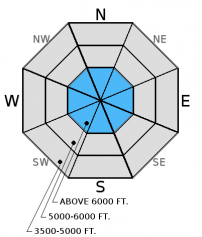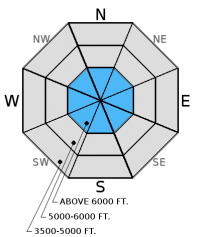| Thursday | Thursday Night | Friday | |
|---|---|---|---|
| Cloud Cover: | Partly cloudy and cold. | Cold and incoming storm | Warming temps and snow. |
| Temperatures: | 1 to 9 deg. F. | -12 to 2 deg. F. | 11 to 18 deg. F. |
| Wind Direction: | East-Northeast | East-Northeast | East-Northeast |
| Wind Speed: | 7 mph | 10 mph | 8 to 9 mph |
| Snowfall: | 0 in. | 1 to 2 in. | 1 to 2 in. |
| Snow Line: |
Whitefish Range
Swan Range
Flathead Range and Glacier National Park
How to read the forecast
The avalanche danger is MODERATE above 6000 feet. Human triggered avalanches are possible on wind-loaded terrain and in locations where weak layers may be buried deeper in the snowpack. Given our wind patterns the past few days, these wind slabs may have formed on aspects that are not typical for the region. Take a little extra time and dig into the snow to look for buried weak layers and choose safer terrain where these weak layers exist.

2. Moderate
?
Above 6500 ft.
1. Low
?
5000-6500 ft.
1. Low
?
3500-5000 ft.
- 1. Low
- 2. Moderate
- 3. Considerable
- 4. High
- 5. Extreme
-
Type ?
-
Aspect/Elevation ?

-
Likelihood ?CertainVery LikelyLikelyPossible
 Unlikely
Unlikely -
Size ?HistoricVery LargeLargeSmall

While the winds have calmed down a bit over the last 24 hours, wind slabs can take several days to gain strength and stabilize on the slope. Moderate easterly and northerly winds earlier this week have loaded slopes on atypical aspects. Continue to look for signs of recent wind-loading such as smooth, chalky pillows of snow especially in exposed terrain above 6000 feet. This includes the lee sides of ridges, cross-loaded gullies, and other terrain features. The skier triggered avalanche in the Skook Chutes of the Whitefish Range on Sunday appears to have been a wind slab created by cross loading. Obvious signs of unstable wind slabs include cracking, whumpfing, and drum-like hollow sounds.
-
Type ?
-
Aspect/Elevation ?

-
Likelihood ?CertainVery LikelyLikelyPossible
 Unlikely
Unlikely -
Size ?HistoricVery LargeLargeSmall

There are weak layers buried deeper in the snowpack that are showing some signs of instability. A freezing rain crust exists in the Whitefish Range. We now have two observations from the southern Whitefish Range that have shown this layer can fracture and propagate in stability tests. Also a layer of weak snow (facets and/or surface hoar) exists about 1.5 to 2 feet below the surface that formed last week. Recent stability tests indicate this layer has the ability to fracture, and this fracture can propagate across the slope (video). It is important to take a little extra the time and dig into the snow to look for these weak layers before committing to a slope. You are more likely to trigger a persistent slab avalanche on slopes with a shallow snowpack and in steep, rocky areas. If you are uncertain about the stability of the snowpack then be more conservative in you decision-making and choose safer terrain.
This early in the season we have relatively limited observations due to difficult access. So there is still some uncertainty in the distribution of these layers and reactivity with the most recent snow load.
Loose, dry avalanches (sluffs) are also possible with the recent, unconsolidated snow. Sluffs can be dangerous in steep terrain and around terrain traps. The effects of even a small loose, dry avalanche can be amplified by traveling in or near a terrain trap like cliffs, tree islands, or narrow gullies.
Remember, the avalanche advisory is a starting point for decision making. The actual avalanche hazard could be greater or lower where you are traveling, especially due to limited early season observations.
We really appreciate the steady flow of observations. Please continue to help us out by letting us know what you are seeing out there. Remember, that even very simple observations like recent avalanche activity, no avalanche activity, or recent snow depths are a huge help. Thank you!
____________________________________________________________________________________________________________
Join us tonight at the Sportsman and Ski Haus in Whitefish at 6:30 for a free 1 hour general avalanche awareness presentation.
On Wednesday December 14 join us for a free motorized avalanche awareness presentation at Penco Power Products in Kalispell at 6:30.
Yesterday BNSF Avalanche Safety travelled above Sheds 11 and 10.7. Some wind slabs had formed in cross-loaded gullies above 5000 feet but were unreactive. No avalanche activity was observed. Winds were light to calm all day with no active wind-loading.
Yesterday skiers in the southern Whitefish range found a freezing rain crust in their snowpit on a southerly aspect at about 6600 feet. This layer fractured and propagated across the column in a stability test. In the Middle Fork toured up Snowshed Mountain above Essex. They noted light to moderate winds that were forming thin wind slabs on easterly aspects.
On Tuesday Erich traveled in the southern Whitefish Range. We found weak layers (facets and a freezing rain crust) about 2 feet below the surface and on some aspects these layers fractured and this fracture propagated across the column - a sign of instability (video). Whitefish Mountain Resort Ski Patrol also found wind slabs to fail on the freezing rain crust in isolated locations during their avalanche mitigation work over the past two days.
On Sunday a skier triggered a soft slab avalanche in the Skook Chutes of the southern Whitefish Range. The avalanche occurred on a cross loaded slope with the bed surface being a thin crust. The crown was 8-12" in depth, 50' wide and ran 700'. The skier was able to safely ski out of the slide.
Currently mountain temperatures are cold, ranging from -12 to 1 degree(s) F. North-East winds decreased over the past 24 hours, averaging 4-6 mph. Today expect continued cold temperatures with light east winds and partly cloudy skies. Late tonight into early tomorrow morning the weather is forecasted to change as storm system moves in from the Pacific. This change to a more active pattern could bring us several inches of new snow starting tomorrow and moving forward through the weekend.
| 0600 temperature: | -12 to 1 deg. F. |
| Max. temperature in the last 24 hours: | -3 to 8 deg. F. |
| Average wind direction during the last 24 hours: | North through East |
| Average wind speed during the last 24 hours: | 4 to 6 mph |
| Maximum wind gust in the last 24 hours: | 5 to 10 mph |
| New snowfall in the last 24 hours: | 0 inches |
| Total snow depth: | 32 to 55 inches |
This advisory applies only to backcountry areas outside established ski area boundaries. This advisory describes general avalanche conditions and local variations always occur. This advisory expires at midnight on the posted day unless otherwise noted. The information in this advisory is provided by the USDA Forest Service who is solely responsible for its content.































